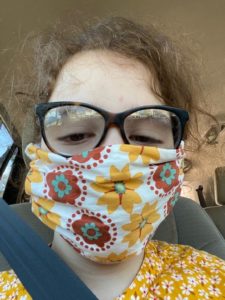About Ableism: Lessons Learned from a Teen Advocate
by Beth

I’m pretty sure ableism wasn’t even a word when I lost my sight in 1986. Don’t get me wrong here: ableism existed 35 years ago, but back then we just called it discrimination. As we approach the 31st anniversary of the Americans with Disabilities Act, now is a good time to acknowledge the discrimination that existed before the ADA and how it still exists today. So what does “ableism” mean, exactly?
This past year and a half, young people have taught me a lot about social justice, equity, and inclusion through their participation in marches, their Zoom talks, webinars, YouTube videos, and speeches. When it comes time for me to learn more about ableism, I am fortunate to have a young expert to go to: my 15-year-old friend Anja Herrman. I came to know Anja very well when she was nine years old and learning at home during a casting program (casts on both legs from her hips down to her ankles). She was schooled at home for two months back then, and I was her at-home writing tutor. Many of her completed assignments were published as guest posts here on our Easterseals National blog, and you can read this post from 2016 to learn how and why she had all her posts back then published under the pen name DJ Mermaid. A high school student, published writer and disability activist now, Dj Mermaid goes by her real name.
Anja K. Herrman was the winner of the Primary Division Playwright Discovery Program at the Kennedy Center in 2019, and a keynote speaker at the #EachforEqual International Women’s Day Event in 2020. Her work has been featured in Magnets and Ladders and Input Magazine and is also forthcoming in the Disabled Writers blog and the Huffington Post.
Anja uses a power wheelchair to navigate her public school, and the stories she recounts in An Essay published in Rooted in Rights last month pretty much spell out what ableism is all about. Two examples:
- She had to advocate on her own for automatic door buttons to be able to access the restrooms at her public school independently.
- When the school elevator broke down, the school administrator in charge simply shrugged and said there was “nothing he could do.”
The broken elevator was particularly problematic, since many of Anja’s classes occurred on the second floor. The ableism comes out loud and clear with the administrator’s answer to the problem at hand. Direct from Anja’s writing:
The school’s genius (I’m being sarcastic here) solution while they were waiting for it to be fixed was to have me sit in an empty classroom without my peers during instruction time doing independent learning (also known as busy work).
Anja had to explain to the principal why this wasn’t suitable. “I wouldn’t be with my peers,” she writes in her essay. “And I was not getting educated to the fullest extent of the school’s duties.” The principal attempted to placate her, she says. “But basically he told me there was nothing he could do.”
So there’s the ableism: dismissing Anja’s needs, deciding that keeping the other students upstairs with their teacher took precedent over her educational needs. You’ll have to read her Rooted in Rights essay to find out what Anja did to advocate for herself here, but I’ll tell you this much: a week later, Anja’s classes were moved downstairs so she could participate.
Anja addresses the idea of allyship in her essay as well, acknowledging that being an ally to the disability community is “a complex dance of knowing when to speak up and when to keep quiet so disabled people can share their experiences.” In the essay she recounts a conversation with her high school theater director about making her costume accessible — tiny buttons don’t work for her. Everything was going along just fine until the director referred to Anja as differently-abled. “I started to do my whole spiel about how using that euphemism is offensive,” She writes. “It erases my identity as a disabled person…it forces me to conform to the ableist view that ‘disability’ is bad and we should avoid naming it at all costs.” Her director’s response was a pleasant surprise for Anja. “I get it, “ he told her. “Your identity is yours to name, and I’ll refer to you the way you choose.”
“It may not seem like much,” Anja writes, “but that was an example of allyship to a student in the disability community…my director listened to my concern and then chose to respect me, an expert on my own disabled body and identity, instead of doubling-down on his comment.” I’ve learned a lot about ableism and allyship from my young talented writer friend Anja, and encourage you to read her Rooted in Rights essay in its entirety, I’ll leave you with one last wonderful excerpt:
Teachers, take note: being an ally doesn’t always have to be some grand gesture; something as simple as listening and changing your stance on an issue could be just as meaningful. But anyone can become an ally — even you! — by taking the time to listen.






